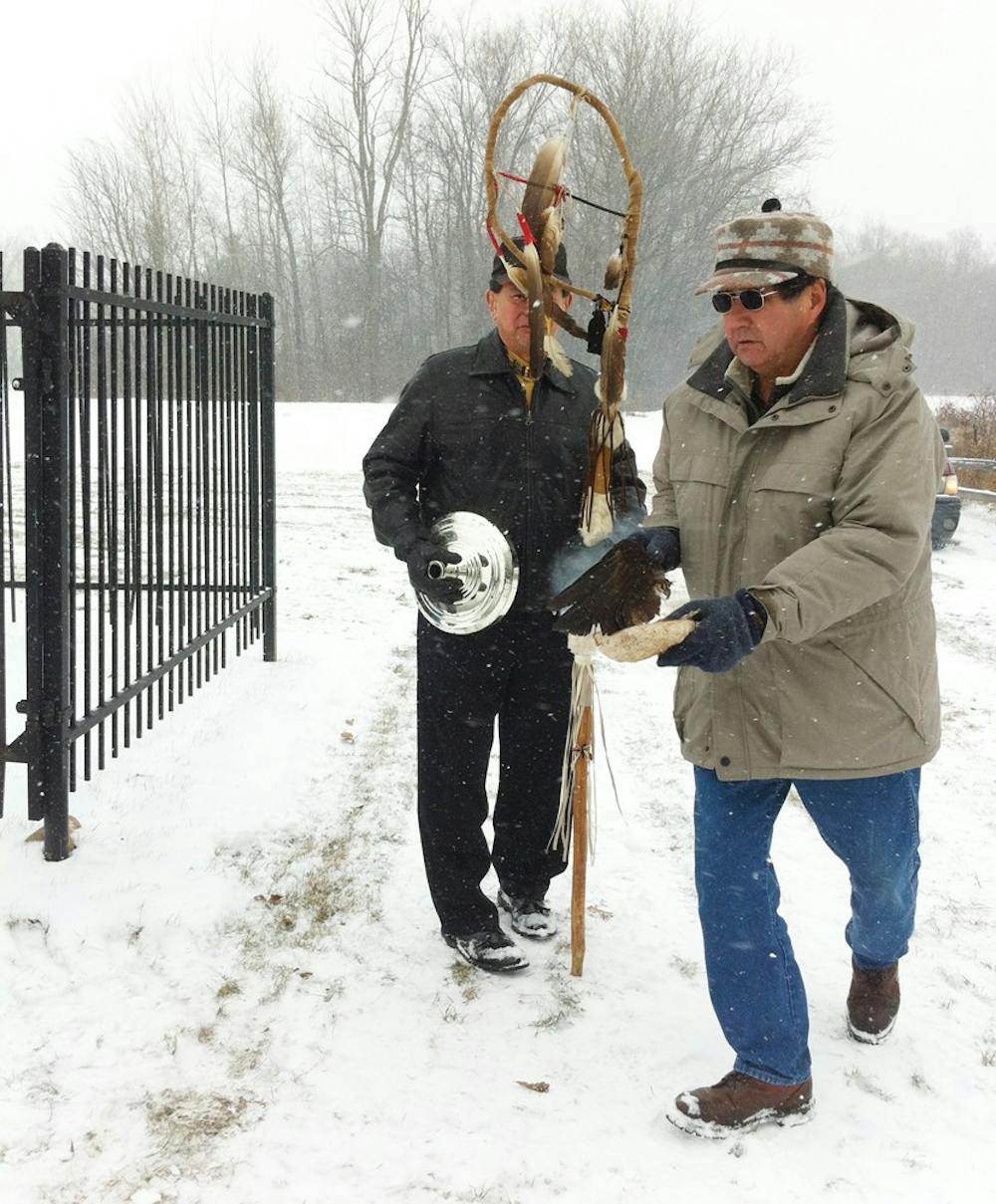Tribal remains buried on reservation
University of Michigan returns ancestral remains to Saginaw Chippewa Indian Tribe in repatriation ceremony

Amidst the snow, wind and smoke coming from a shell of burning sage, several ancestors of the Saginaw Chippewa Indian Tribe were finally laid to rest on Wednesday after a decade-long attempt to release them from the University of Michigan's Museum of Anthropological Archaeology.
Since the Native American Graves Protection and Repatriation Act (NAGPRA) was passed in 1990, universities and museums have been required to identify all the Native American remains and artifacts they hold as a result of centuries of archaeological excavation and return them to their rightful tribes.
Frank Cloutier, the director of public relations for the Tribe, said some people have trouble understanding why ancestral remains need to be returned when they're being cared for in a museum.
"A lot of people have asked me that. They say, 'They're there, they're being cared for.' No they're not. They're being decimated," Cloutier said. "They're being carbon dated, they're using DNA grindings of human remains to date them. There's no respect. There's no reverence for these creatures who were once human beings and walking the face of this earth."
On Wednesday, dozens of Tribe and community members gathered at the Nibokaan Ancestral Cemetery on the Isabella Indian Reservation to participate in the ceremony that would return the remains of 94 individuals and 812 burial object artifacts to the earth from which they were dug up. Several bundles of remains, including bones, teeth, skull fragments and pottery pieces were prepared at the Ziibiwing Cultural Center in Mount Pleasant earlier that morning.
They were wrapped in red, the Tribe's sacred color, and only put to rest after an opening song had been performed and the grave had been prepared with layers of birch bark and cedar, one of the Tribe's main medicines.
According to Charmaine Shawana, the tribal historic preservation officer and an elder, the remains given to the Tribe came from Lapeer County, where the Saginaw Chippewa Indian Tribe has records of having ancestors.
"All the universities had to inventory and tell the tribes what they had exactly," Shawana said. "We knew that we had ancestors at the University of Michigan, and we started eight to ten years ago. It's a long process, and we finally appealed to the Board of Regents. We finally got them to OK the release of our ancestors."
For the Tribe, burying the remains according to tradition is important for the souls of those remains to be able to pass on properly. The process to release remains from public universities, however, is not an easy one.
Ben Secunda is the NAGPRA project manager in U of M's Office of Research, and said identifying the school's inventory and preparing them for return to Michigan's 52 federally recognized tribes is difficult at times.
"We work with tribes to accommodate as many requests that they have from the ceremonial perspective," Secunda said.
Due to another federal regulation, Secunda said universities must recognize which tribes have aboriginal standing in the area where remains are found. If more than one tribe is found to have that standing, they must decide among themselves to which tribe the remains will be given.
In the case of the Lapeer remains, almost all 52 Michigan tribes had aboriginal standing, but the Saginaw Chippewa Indian Tribe was chosen as the recipient.
"We have to observe a legal process and know who to contact," Secunda said. "Contacting all of the tribes, getting requests from all of them and consulting with all of them, and then getting them to communicate to who's going to be taking the lead for their burial purposes is part of that process. It's just a lot of communication, a lot of coordination and eventually it happens."
In this case, Secunda said DNA samples had been taken from the remains, but not as a way of dating or identifying them. A research project had been started with the remains at the university, but it was never finished or conducted with the consent of the tribes.
Those DNA samples were removed from their vials and buried along with the rest of the remains, Shawana said.
Central Michigan University has its own ties to NAGPRA and the repatriation process, as it returned the remains and burial objects of 144 Native American ancestors to the Tribe in 2010. The remains had been held in the university's Museum of Cultural and Natural History, and College of Humanities and Social and Behavioral Science Dean Pamela Gates had a large hand in returning them.
According to Gates, a restructuring in the early 2000's led to the museum passing from the College of Communication and Fine Arts to CHSBS. As the Associate Dean at the time, it was Gates' job to manage the space the college had all over the university, including the museum.
"As I was getting a tour, one of the student workers who was there in the summertime, as we were walking through and there was this door that was shut, said 'This is where the remains are,' and I said 'What are you talking about?'" Gates said. "I had been here a very long time and I had never heard that we had Native American remains. From floor to ceiling there were bankers boxes of ancestors, and I was sick to my stomach."
After speaking with then-Dean Shapiro, Gates helped start the discussions that eventually led to the repatriation. Anthropology professors helped with identifying and documenting the remains, and in 2010 university members were able to walk the remains from the museum to the Tribe's cemetery for burial.
"I know where my grandparents are buried. To think that these were parents, grandparents, great-grandparents, ancestors, I was upset," Gates said. "It was the most powerful experience I've ever participated in."



